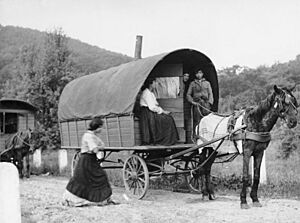Sinti facts for kids
| Total population | |
|---|---|
| ≈ 20ll 500,000 | |
| Languages | |
| Sinte Romani | |
| Related ethnic groups | |
| Other Indo-Aryan peoples, especially Roma (Manouche) |
The Sinti are a group of Romani people. They are mainly found in countries like Germany, France, and Italy. About 200,000 Sinti people live in Central Europe.
In the past, Sinti people often traveled from place to place. Today, most Sinti have settled down. Only a small number still travel. The Sinti in Central Europe are closely related to a group called the Manouche in France.
Sinti people speak a language called Sinte Romani. This language is a type of Romani language. It has been greatly influenced by the German language.
Contents
Where the Sinti People Came From
The Sinti people, like all Romani people, originally came from the Indian subcontinent. Some scholars believe the name "Sinti" might come from "Sindhi." This refers to people from the Sindh region of India. Today, Sindh is part of Pakistan.
However, the exact origin of the name "Sinti" is debated. Some experts think the word "Sinti" is a newer term. They believe it might have come from a European language. For example, it could be from the German word Reisende, which means 'travelers'.
Recent studies have looked at the genes of Romani men in Europe. They found similarities with men from India. This supports the idea that Romani people, including the Sinti, came from India.
A Brief History of the Sinti
The Sinti are a subgroup of Romani people. They are mostly found in Germany. They arrived in places like Austria and Germany during the Late Middle Ages. This was part of a larger movement of Romani people from the Indian Subcontinent.
Over time, the Sinti split into two main groups. One group, called Eftavagarja, moved into France and Portugal. They are now known as "Manouches" in those areas. The other group, Estraxarja, moved into Italy and Central Europe. This includes countries like Croatia, Slovenia, and Hungary.
The Holocaust and Sinti People
The Sinti arrived in Germany in the early 1400s. Even after living there for a long time, they faced unfair treatment. By the late 1800s, police began keeping records on Sinti and other Romani groups.
During the time of Nazi Germany, the Sinti were seen as racially inferior. The Nazis persecuted them throughout Germany. The Nuremberg Laws of 1935, which targeted Jewish people, were also often used against the Sinti.
Nazi leaders decided to deport the Sinti people. They wanted to make room for other Germans. Many Sinti were sent to Poland or other places. Some were even sent to Yugoslavia in 1939. Others were forced to live in special areas. Sadly, many Sinti were later murdered in gas chambers.
Many Sinti and Roma people were taken to Auschwitz-Birkenau. They were put in a special section called the "gypsy camp." On August 2, 1944, this camp was closed. About 4,000 Sinti and Roma were killed in gas chambers that night. This date, August 2, is now remembered as Roma and Sinti Holocaust Remembrance Day.
In the concentration camps, Sinti people were forced to wear special symbols. They wore either a black triangle, meaning they were "asocial," or a brown triangle. The brown triangle was specifically for Sinti, Roma, and Yenish peoples.
Famous Sinti People
Many Sinti individuals have become well-known in different fields. Here are a few examples:
- Anita Awosusi (born 1956) - a writer, musician, and activist.
- Ayo (born 1980) - a singer, songwriter, and actress.
- Wawau Adler (born 1967) - a talented jazz guitarist.
- Drafi Deutscher (1946 - 2006) - a popular singer and songwriter.
- Philomena Franz (1922-2022) - a writer and Holocaust survivor.
- Marianne Rosenberg (born 1955) - a singer.
- Otto Rosenberg (1927 - 2001) - a writer, activist, and Holocaust survivor.
- Sido (born 1980) - a famous rapper.
- Johann Trollmann (1907 - 1944) - a boxer who faced persecution during the Holocaust.
- Häns'che Weiss (1951-2016) - a jazz musician.
Images for kids
-
Deportation of Sinti and Roma in Asperg, 22 May 1940
-
Ravensburg, Memorial for Sinti murdered in Auschwitz
See also
 In Spanish: Sinti para niños
In Spanish: Sinti para niños
- Antiziganism (prejudice against Romani people)
- History of the Romani people
- Romani people by country
- Romani people in Germany
- Sinte Romani (the Sinti language)







